Synthesis and Characterization of Ni-Doped Iron Oxide/GO Nanoparticles by Co-Precipitation Method for Electrocatalytic Oxygen Reduction Reaction in Microbial Fuel Cells
Abstract
:1. Introduction
2. Materials and Methods
2.1. Synthesis of Graphene Oxide by Hummers’ Method
2.2. Nickel-Doped Iron Oxide/Graphene Oxide Synthesis
2.3. Characterization
2.4. Fabrication of Electrodes for ORR
2.5. Electrochemical Measurements
2.6. Construction of Single Chamber Microbial Fuel Cells (MFCs)
2.6.1. Inoculation of the Reactor
2.6.2. MFC Operation
3. Results and Discussion
3.1. XRD Analysis
3.2. TGA/DTG Analysis
3.3. FTIR Analysis
3.4. Raman Analysis
3.5. Electrochemical Characterization of Air Cathodes
MFC Performance with Different Electrocatalysts
3.6. SEM Analysis
3.7. TEM Analysis
3.8. SEM/EDS Analysis of the MFC Electrodes
4. Conclusions
Author Contributions
Funding
Institutional Review Board Statement
Informed Consent Statement
Data Availability Statement
Acknowledgments
Conflicts of Interest
Abbreviations
| MFC | Microbial Fuel Cell |
| ORR | Oxygen Reduction Reaction |
| GO | Graphene Oxide |
| SEM | Scanning Electron Microscopy |
| TEM | Transmission Electron Microscopy |
| OCV | Open Circuit Voltage |
| TGA | Thermogravimetric Analysis |
| DTG | Derivative Thermogravimetric Analysis |
| EDS | Energy Dispersive Spectroscopy |
References
- Bunyanidhi, P.; Phattharasupakun, N.; Duangdangchote, S.; Prempluem, S.; Joraleechanchai, N.; Sawangphruk, M. Exploring the impact of metal oxide coating and metal atom doping on the electrochemical performance of Ni-rich cathode materials. J. Mater. Chem. A Mater. 2023, 11, 23223–23227. [Google Scholar] [CrossRef]
- Bazina, N.; Ahmed, T.G.; Almdaaf, M.; Jibia, S.; Sarker, M. Power generation from wastewater using microbial fuel cells: A review. J. Biotechnol. 2023, 374, 17–30. [Google Scholar] [CrossRef] [PubMed]
- Sun, Y.; Li, H.; Guo, S.; Li, C. Metal-based cathode catalysts for electrocatalytic ORR in microbial fuel cells: A review. Chin. Chem. Lett. 2024, 35, 109418. [Google Scholar] [CrossRef]
- Pollet, B.G.; Kalanur, S.S. Applications of Ferric Oxide in Water Splitting by Electrolysis: A Comprehensive Review. Molecules 2024, 29, 4990. [Google Scholar] [CrossRef]
- Han, J.; Bian, J.; Sun, C. Recent Advances in Single-Atom Electrocatalysts for Oxygen Reduction Reaction. Research 2020, 2020, 9512763. [Google Scholar] [CrossRef] [PubMed]
- Matseke, M.S.; Luo, H.; Wen, L.; Zheng, H. The upgraded performance of the NiFe2O4 /C electrocatalyst using Co substitution for the oxygen reduction reaction in an alkaline solution. J. Phys. Chem. Solids 2022, 165, 110644. [Google Scholar] [CrossRef]
- Kumar, N.; Ansari, M.R.; Khaladkar, S.; Maurya, O.; Peta, K.R.; Kalekar, A.; Singha, M.K.; Dash, J.K. NiFe2O4 nanoparticles as highly efficient catalyst for oxygen reduction reaction and energy storage in supercapacitor. Mater. Chem. Phys. 2024, 316, 129072. [Google Scholar] [CrossRef]
- Zhang, Y.; Zhang, Y.; Li, C.; Yan, X.; Hu, S.; Yin, R.; Wei, Y.; Gao, K.; Gao, H. Research progress of NiFe2O4 electrode materials in supercapacitors: Preparation, modification, structural regulation, and future challenges. Coord. Chem. Rev. 2024, 519, 216103. [Google Scholar] [CrossRef]
- Zhang, L.; Fan, Q.; Li, K.; Zhang, S.; Ma, X. First-row transition metal oxide oxygen evolution electrocatalysts: Regulation strategies and mechanistic understandings. Sustain. Energy Fuels 2020, 4, 5417–5432. [Google Scholar] [CrossRef]
- Feng, Z.; Wang, P.; Cheng, Y.; Mo, Y.; Luo, X.; Liu, P.; Guo, R.; Liu, X. Recent progress on NiFe2O4 spinels as electrocatalysts for the oxygen evolution reaction. J. Electroanal. Chem. 2023, 946, 117703. [Google Scholar] [CrossRef]
- Askari, M.B.; Salarizadeh, P. Binary nickel ferrite oxide (NiFe2O4) nanoparticles coated on reduced graphene oxide as stable and high-performance asymmetric supercapacitor electrode material. Int. J. Hydrogen Energy 2020, 45, 27482–27491. [Google Scholar] [CrossRef]
- Yano, H.; Iwasaki, K. Size-Dependence of the Electrochemical Activity of Platinum Particles in the 1 to 2 Nanometer Range. Surfaces 2024, 7, 472–481. [Google Scholar] [CrossRef]
- Ghasemi, S.; Gheshlaghi, R.; Mahdavi, M.A.; Abazarian, E. Evaluation of low-cost carbon/metal electrodes as cathodes and anodes in sediment microbial fuel cells. Fuel 2024, 373, 132349. [Google Scholar] [CrossRef]
- Alves, C.T.; Onwudili, J.A. Screening of Nickel and Platinum Catalysts for Glycerol Conversion to Gas Products in Hydrothermal Media. Energies 2022, 15, 7571. [Google Scholar] [CrossRef]
- Soufi, A.; Hajjaoui, H.; Elmoubarki, R.; Abdennouri, M.; Qourzal, S.; Barka, N. Spinel ferrites nanoparticles: Synthesis methods and application in heterogeneous Fenton oxidation of organic pollutants—A review. Appl. Surf. Sci. Adv. 2021, 6, 100145. [Google Scholar] [CrossRef]
- Fan, Y.; Li, R.; Zhao, C.; Hu, A.; Zhou, B.; Pan, Y.; Chen, J.; Yan, Z.; Liu, M.; He, M.; et al. Chromium-doped inverse spinel electrocatalysts with optimal orbital occupancy for facilitating reaction kinetics of lithium-oxygen batteries. J. Colloid. Interface Sci. 2023, 645, 439–447. [Google Scholar] [CrossRef]
- Janani, G.; Chae, Y.; Surendran, S.; Sim, Y.; Park, W.; Kim, J.K.; Sim, U. Rational Design of Spinel Oxide Nanocomposites with Tailored Electrochemical Oxygen Evolution and Reduction Reactions for ZincAir Batteries. Appl. Sci. 2020, 10, 3165. [Google Scholar] [CrossRef]
- Sabaa, H.M.; El-Khatib, K.M.; El-Kady, M.Y.; Mahmoud, S.A. Spinel structure of activated carbon supported MFe2O4 composites as an economic and efficient electrocatalyst for oxygen reduction reaction in neutral media. J. Solid. State Electrochem. 2022, 26, 2749–2763. [Google Scholar] [CrossRef]
- Buaki-Sogó, M.; Zubizarreta, L.; García-Pellicer, M.; Quijano-López, A. Sustainable Carbon as Efficient Support for Metal-Based Nanocatalyst: Applications in Energy Harvesting and Storage. Molecules 2020, 25, 3123. [Google Scholar] [CrossRef]
- Wang, H.; Hu, Q.; Qiu, J.; Guo, R.; Liu, X. Research progress of spinel CoFe2O4 as an electrocatalyst for the oxygen evolution reaction. Catal. Sci. Technol. 2023, 13, 6102–6125. [Google Scholar] [CrossRef]
- Eppstein, R.; Toroker, M.C. On the Interplay Between Oxygen Vacancies and Small Polarons in Manganese Iron Spinel Oxides. ACS Mater. Au 2022, 2, 269–277. [Google Scholar] [CrossRef] [PubMed]
- Mladenović, D.; Mladenović, A.; Santos, D.M.F.; Yurtcan, A.B.; Miljanić, Š.; Mentus, S.; Šljukić, B. Transition metal oxides for bifunctional ORR/OER electrocatalysis in unitized regenerative fuel cells. J. Electroanal. Chem. 2023, 946, 117709. [Google Scholar] [CrossRef]
- Ma, W.; Wu, F.; Yu, P.; Mao, L. Carbon support tuned electrocatalytic activity of a single-site metal–organic framework toward the oxygen reduction reaction. Chem. Sci. 2021, 12, 7908–7917. [Google Scholar] [CrossRef]
- Gothandapani, K.; Jeniffer, R.S.; Selvi, G.T.; Velmurugan, V.; Assaifan, A.K.; Alzahrani, K.E.; Albrithen, H.; Muthuramamoorthy, M.; Pandiaraj, S.; Pitchaimuthu, S.; et al. Nickel nanoparticles supported on carbon surface as an electrocatalyst for hydrogen evolution reaction. Int. J. Hydrogen Energy 2024, 52, 1137–1146. [Google Scholar] [CrossRef]
- Abaft, E.; Taleghani, H.G.; Lashkenari, M.S. 3D graphene oxide/nickel ferrite aerogel for high-performance supercapacitor application. J. Energy Storage 2024, 98, 112797. [Google Scholar] [CrossRef]
- Qavami, A.; Ghasemi, S. Nickel-cobalt manganate supported on reduced graphene oxide/carbon nanotube for improving air cathode performance in single chamber microbial fuel cell. Mater. Sci. Eng. B 2022, 275, 115492. [Google Scholar] [CrossRef]
- Almansoori, A.; Balázsi, K.; Balázsi, C. Advances, Challenges, and Applications of Graphene and Carbon Nanotube-Reinforced Engineering Ceramics. Nanomaterials 2024, 14, 1881. [Google Scholar] [CrossRef]
- Kang, S.; Kim, H.; Chung, Y.-H. Recent developments of nano-structured materials as the catalysts for oxygen reduction reaction. Nano Converg. 2018, 5, 13. [Google Scholar] [CrossRef]
- Burkholder, M.B.; Rahman, F.B.A.; Chandler, E.H.; Regalbuto, J.R.; Gupton, B.F.; Tengco, J.M.M. Metal supported graphene catalysis: A review on the benefits of nanoparticular supported specialty sp2 carbon catalysts on enhancing the activities of multiple chemical transformations. Carbon. Trends 2022, 9, 100196. [Google Scholar] [CrossRef]
- Qamar, S.; Ramzan, N.; Aleem, W. Graphene dispersion, functionalization techniques and applications: A review. Synth. Met. 2024, 307, 117697. [Google Scholar] [CrossRef]
- Ghulam, A.N.; Santos, O.A.L.D.; Hazeem, L.; Backx, B.P.; Bououdina, M.; Bellucci, S. Graphene Oxide (GO) Materials—Applications and Toxicity on Living Organisms and Environment. J. Funct. Biomater. 2022, 13, 77. [Google Scholar] [CrossRef]
- Narayan, J.; Bezborah, K. Recent advances in the functionalization, substitutional doping and applications of graphene/graphene composite nanomaterials. RSC Adv. 2024, 14, 13413–13444. [Google Scholar] [CrossRef] [PubMed]
- Kong, Z.; Wu, J.; Liu, Z.; Yan, D.; Wu, Z.; Zhong, C. Advanced electrocatalysts for fuel cells: Evolution of active sites and synergistic properties of catalysts and carrier materials. Exploration 2025, 5, 20230052. [Google Scholar] [CrossRef]
- Gnanaseelan, N.; Latha, M.; Mantilla, A.; Sathish-Kumar, K.; Caballero-Briones, F. The role of redox states and junctions in photocatalytic hydrogen generation of MoS2-TiO2-rGO and CeO2-Ce2Ti3O8.7-TiO2-rGO composites. Mater. Sci. Semicond. Process 2020, 118, 105185. [Google Scholar] [CrossRef]
- Gnanaseelan, N.; Marasamy, L.; Mantilla, A.; Kamaraj, S.K.; Espinosa-Faller, F.J.; Caballero-Briones, F. Exploring the impact of doping and co-doping with B and N on the properties of graphene oxide and its photocatalytic generation of hydrogen. Int. J. Hydrogen Energy 2022, 47, 40905–40919. [Google Scholar] [CrossRef]
- Guerrero-Contreras, J.; Caballero-Briones, F. Graphene oxide powders with different oxidation degree. prepared by synthesis variations of the Hummers method. Mater. Chem. Phys. 2015, 153, 209–220. [Google Scholar] [CrossRef]
- Espinosa-Faller, F.J.; Hoy-Benítez, J.; Colina-Ruiz, R.A.; Contreras, J.G.; de León, J.M.; Lezama-Pacheco, J.S.; Llamazares, J.L.S.; Caballero-Briones, F. Magnetic properties of nano(iron oxide)-decorated graphene oxide. Mater. Chem. Phys. 2024, 317, 129173. [Google Scholar] [CrossRef]
- Yao, Y.; Miao, S.; Liu, S.; Ma, L.P.; Sun, H.; Wang, S. Synthesis, characterization, and adsorption properties of magnetic Fe3O4@graphene nanocomposite. Chem. Eng. J. 2012, 184, 326–332. [Google Scholar] [CrossRef]
- Kazi, S.; Inamdar, S.; Sarnikar, Y.; Kamble, D.; Tigote, R. Simple Co-precipitation synthesis and characterization of magnetic spinel NiFe2O4 nanoparticles. Mater. Today Proc. 2023, 73, 448–454. [Google Scholar] [CrossRef]
- Li, L.; Liao, Q.; Liu, C.; Zhang, T.; Liu, C.; Chen, Z.; Gao, R.; He, Q. Enhanced biological wastewater treatment supplemented with anaerobic fermentation liquid of primary sludge. J. Env. Manag. 2023, 347, 119086. [Google Scholar] [CrossRef]
- Liang, H.; Han, J.; Yang, X.; Qiao, Z.; Yin, T. Performance improvement of microbial fuel cells through assembling anodes modified with nanoscale materials. Nanomater. Nanotechnol. 2022, 12, 184798042211329. [Google Scholar] [CrossRef]
- Shirkosh, M.; Hojjat, Y.; Mardanpour, M.M. Boosting microfluidic microbial fuel cells performance via investigating electron transfer mechanisms. metal-based electrodes, and magnetic field effect. Sci. Rep. 2022, 12, 7417. [Google Scholar] [CrossRef] [PubMed]
- Ikram, R.; Jan, B.M.; Ahmad, W. An overview of industrial scalable production of graphene oxide and analytical approaches for synthesis and characterization. J. Mater. Res. Technol. 2020, 9, 11587–11610. [Google Scholar] [CrossRef]
- Hassanzadeh-Tabrizi, S.A. Precise calculation of crystallite size of nanomaterials: A review. J. Alloys Compd. 2023, 968, 171914. [Google Scholar] [CrossRef]
- La, G.H.; Lee, S.H.; Min, D.J. Fundamental study on preferential reduction of Ni in NiFe2O4. Miner. Eng. 2021, 164, 106829. [Google Scholar] [CrossRef]
- Belotcerkovtceva, D.; Maciel, R.P.; Berggren, E.; Maddu, R.; Sarkar, T.; Kvashnin, Y.O.; Thonig, D.; Lindblad, A.; Eriksson, O.; Kamalakar, M.V. Insights and Implications of Intricate Surface Charge Transfer and sp3-Defects in Graphene/Metal Oxide Interfaces. ACS Appl. Mater. Interfaces 2022, 14, 36209–36216. [Google Scholar] [CrossRef] [PubMed]
- Sivagurunathan, P.; Gibin, S.R. Preparation and characterization of nickel ferrite nano particles by co-precipitation method with citrate as chelating agent. J. Mater. Sci. Mater. Electron. 2016, 27, 2601–2607. [Google Scholar] [CrossRef]
- da Guarda Souza, M.O.; Santos, M.V.R.D.; Castro, L.M.F.; da Silva, C.P. Production and in situ transformation of hematite into magnetite from the thermal decomposition of iron nitrate or goethite mixed with biomass. J. Therm. Anal. Calorim. 2020, 139, 1731–1739. [Google Scholar] [CrossRef]
- Farzan, A.; Borandeh, S.; Seppälä, J. Conductive polyurethane/PEGylated graphene oxide composite for 3D-printed nerve guidance conduits. Eur. Polym. J. 2022, 167, 111068. [Google Scholar] [CrossRef]
- Brusko, V.; Khannanov, A.; Rakhmatullin, A.; Dimiev, A.M. Unraveling the infrared spectrum of graphene oxide. Carbon 2024, 229, 119507. [Google Scholar] [CrossRef]
- Flores-Cano, D.A.; Checca-Huaman, N.-R.; Castro-Merino, I.-L.; Pinotti, C.N.; Passamani, E.C.; Litterst, F.J.; Ramos-Guivar, J.A. Progress toward Room-Temperature Synthesis and Functionalization of Iron-Oxide Nanoparticles. Int. J. Mol. Sci. 2022, 23, 8279. [Google Scholar] [CrossRef] [PubMed]
- Alshahrani, A.; Bin-Shuwaish, M.S.; Al-Hamdan, R.S.; Almohareb, T.; Maawadh, A.M.; Al Deeb, M.; Alhenaki, A.M.; Abduljabbar, T.; Vohra, F. Graphene oxide nano-filler based experimental dentine adhesive. A SEM/EDX, Micro-Raman and microtensile bond strength analysis. J. Appl. Biomater. Funct. Mater. 2020, 18, 228080002096693. [Google Scholar] [CrossRef]
- Khalil, K.A.; Barakat, N.A.M.; Motlak, M.; Al-Mubaddel, F.S. A novel graphene oxide-based ceramic composite as an efficient electrode for capacitive deionization. Sci. Rep. 2020, 10, 9676. [Google Scholar] [CrossRef]
- Kumar, S.; Ahmed, F.; Shaalan, N.M.; Arshi, N.; Dalela, S.; Chae, K.H. Investigations of Structural, Magnetic, and Electrochemical Properties of NiFe2O4 Nanoparticles as Electrode Materials for Supercapacitor Applications. Materials 2023, 16, 4328. [Google Scholar] [CrossRef]
- More, S.; Raut, S.; Premkumar, S.; Bhopale, S.; Bhoraskar, S.; More, M.; Mathe, V. Structural and morphological tuning of iron oxide polymorphs by ECR plasma-assisted thermal oxidation. RSC Adv. 2020, 10, 32088–32101. [Google Scholar] [CrossRef] [PubMed]
- Ye, Q.; Hunter, T.N.; Xu, H.; Harbottle, D.; Kale, G.M.; Tillotson, M.R. Synergistic effect of Fe and Ni on carbon aerogel for enhanced oxygen reduction and H2O2 activation in electro-Fenton process. Sep. Purif. Technol. 2025, 353, 128436. [Google Scholar] [CrossRef]
- Wang, Z.; Zhu, H.; Ai, L.; Ding, J.; Zhu, P.; Li, Z.; Li, B.; Jiang, H.; Yu, F.; Duan, X.; et al. Synthesis, Electronic Structure. and Electrochemical Properties of the Cubic Mg2MnO4 Spinel with Porous-Spongy Structure. Nanomaterials 2021, 11, 1122. [Google Scholar] [CrossRef]
- Blatter, M.; Delabays, L.; Furrer, C.; Huguenin, G.; Cachelin, C.P.; Fischer, F. Stretched 1000-L microbial fuel cell. J. Power Sources 2021, 483, 229130. [Google Scholar] [CrossRef]
- Qiu, S.; Wang, L.; Zhang, Y.; Yu, Y. Microbial Fuel Cell-Based Biosensor for Simultaneous Test of Sodium Acetate and Glucose in a Mixed Solution. Int. J. Env. Res. Public Health 2022, 19, 12297. [Google Scholar] [CrossRef]
- Wang, H.; Wei, L.; Yang, C.; Liu, J.; Shen, J. A pyridine-Fe gel with an ultralow-loading Pt derivative as ORR catalyst in microbial fuel cells with long-term stability and high output voltage. Bioelectrochemistry 2020, 131, 107370. [Google Scholar] [CrossRef]
- Huang, Q.; Zhou, P.; Yang, H.; Zhu, L.; Wu, H. In situ generation of inverse spinel CoFe2O4 nanoparticles onto nitrogen-doped activated carbon for an effective cathode electrocatalyst of microbial fuel cells. Chem. Eng. J. 2017, 325, 466–473. [Google Scholar] [CrossRef]
- Hu, Z.; Zhou, X.; Lu, Y.; Jv, R.; Liu, Y.; Li, N.; Chen, S. CoMn2O4 doped reduced graphene oxide as an effective cathodic electrocatalyst for ORR in microbial fuel cells. Electrochim. Acta 2019, 296, 214–223. [Google Scholar] [CrossRef]
- Wu, X.-T.; Li, J.-C.; Pan, Q.-R.; Li, N.; Liu, Z.-Q. Gallic acid-assisted synthesis of Pd uniformly anchored on porous N-rGO as efficient electrocatalyst for microbial fuel cells. Dalton Trans. 2018, 47, 1442–1450. [Google Scholar] [CrossRef]
- Harshiny, M.; Samsudeen, N.; Kameswara, R.J.; Matheswaran, M. Biosynthesized FeO nanoparticles coated carbon anode for improving the performance of microbial fuel cell. Int. J. Hydrogen Energy 2017, 42, 26488–26495. [Google Scholar] [CrossRef]
- Li, M.; Zhou, S. α-Fe2O3/polyaniline nanocomposites as an effective catalyst for improving the electrochemical performance of microbial fuel cell. Chem. Eng. J. 2018, 339, 539–546. [Google Scholar] [CrossRef]
- Choi, Y.-J.; Mohamed, H.O.; Park, S.-G.; Al Mayyahi, R.B.; Al-Dhaifallah, M.; Rezk, H.; Ren, X.; Yu, H.; Chae, K.-J. Electrophoretically fabricated nickel/nickel oxides as cost effective nanocatalysts for the oxygen reduction reaction in air-cathode microbial fuel cell. Int. J. Hydrogen Energy 2020, 45, 5960–5970. [Google Scholar] [CrossRef]
- Xia, W.-Y.; Tan, L.; Li, N.; Li, J.-C.; Lai, S.-H. Nickel cobaltite@nanocarbon hybrid materials as efficient cathode catalyst for oxygen reduction in microbial fuel cells. J. Mater. Sci. 2017, 52, 7539–7545. [Google Scholar] [CrossRef]
- Laobuthee, A.; Khankhuean, A.; Panith, P.; Veranitisagul, C.; Laosiripojana, N. Ni–Fe Cocatalysts on Magnesium Silicate Supports for the Depolymerization of Kraft Lignin. ACS Omega 2023, 8, 8675–8682. [Google Scholar] [CrossRef]
- Fang, L.J.; Wang, X.L.; Li, Y.H.; Liu, P.F.; Wang, Y.L.; Zeng, H.D.; Yang, H.G. Nickel nanoparticles coated with graphene layers as efficient co-catalyst for photocatalytic hydrogen evolution. Appl. Catal. B 2017, 200, 578–584. [Google Scholar] [CrossRef]
- Deng, S.; Berry, V. Wrinkled, rippled and crumpled graphene: An overview of formation mechanism, electronic properties, and applications. Mater. Today 2016, 19, 197–212. [Google Scholar] [CrossRef]
- Kueh, T.C.; Chew, S.H.; Soh, A.K.; Hung, Y.M. Investigation of the influence of the location of oxygenated functional groups in graphene nanostructures on water permeation via molecular dynamics simulations. Appl. Surf. Sci. 2023, 609, 155414. [Google Scholar] [CrossRef]
- Yu, W.; Sisi, L.; Haiyan, Y.; Jie, L. Progress in the functional modification of graphene/graphene oxide: A review. RSC Adv. 2020, 10, 15328–15345. [Google Scholar] [CrossRef] [PubMed]
- Briones, F.C.; Guerrero-Contreras, J.; Benito-Santiago, S.E.; Llamazares, J.L.S.; Espinosa-Faller, F.J. Formation of magnetic nanoscrolls and nanoribbons in iron oxide-decorated graphene oxide. Mater. Lett. 2022, 309, 131321. [Google Scholar] [CrossRef]

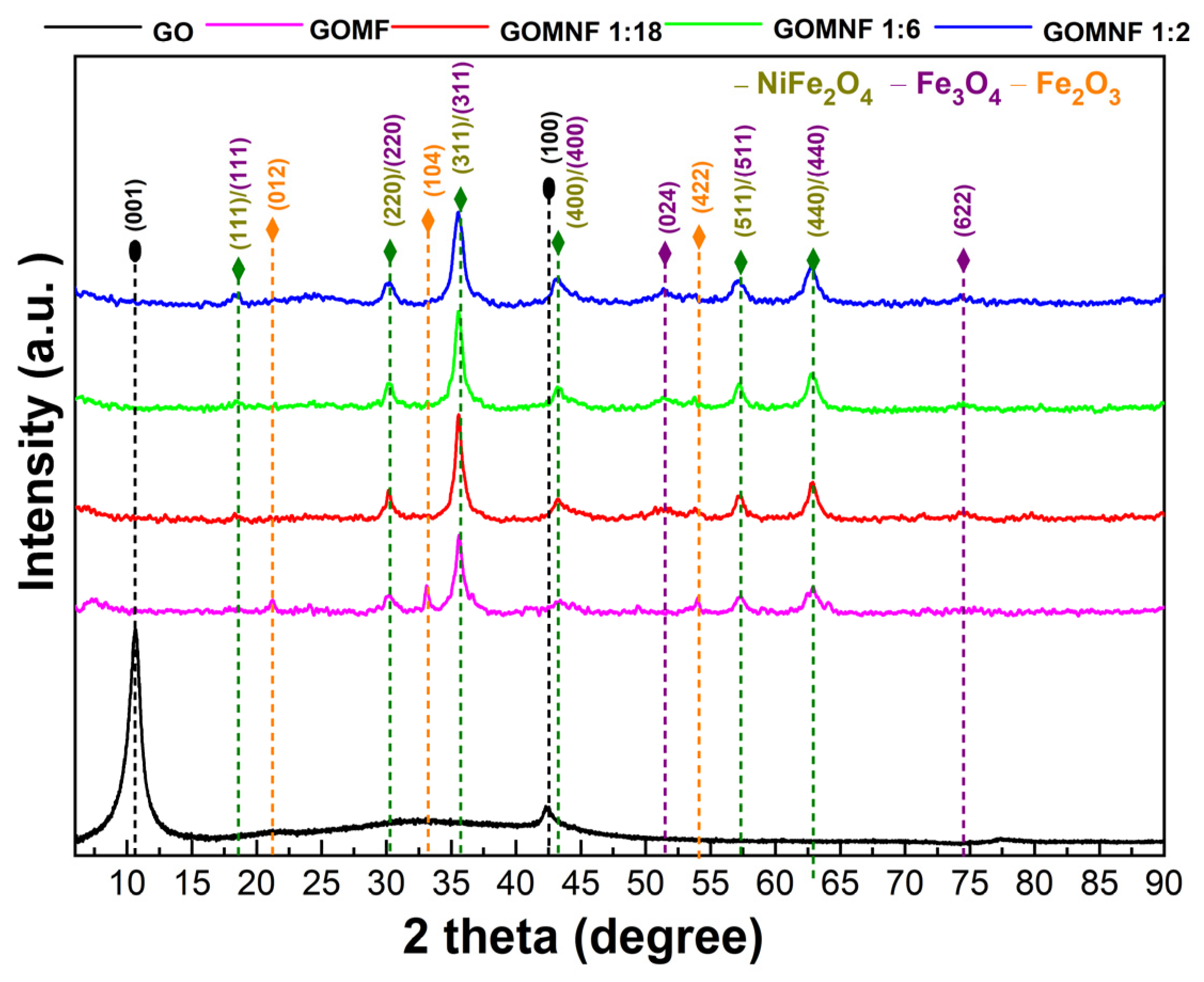
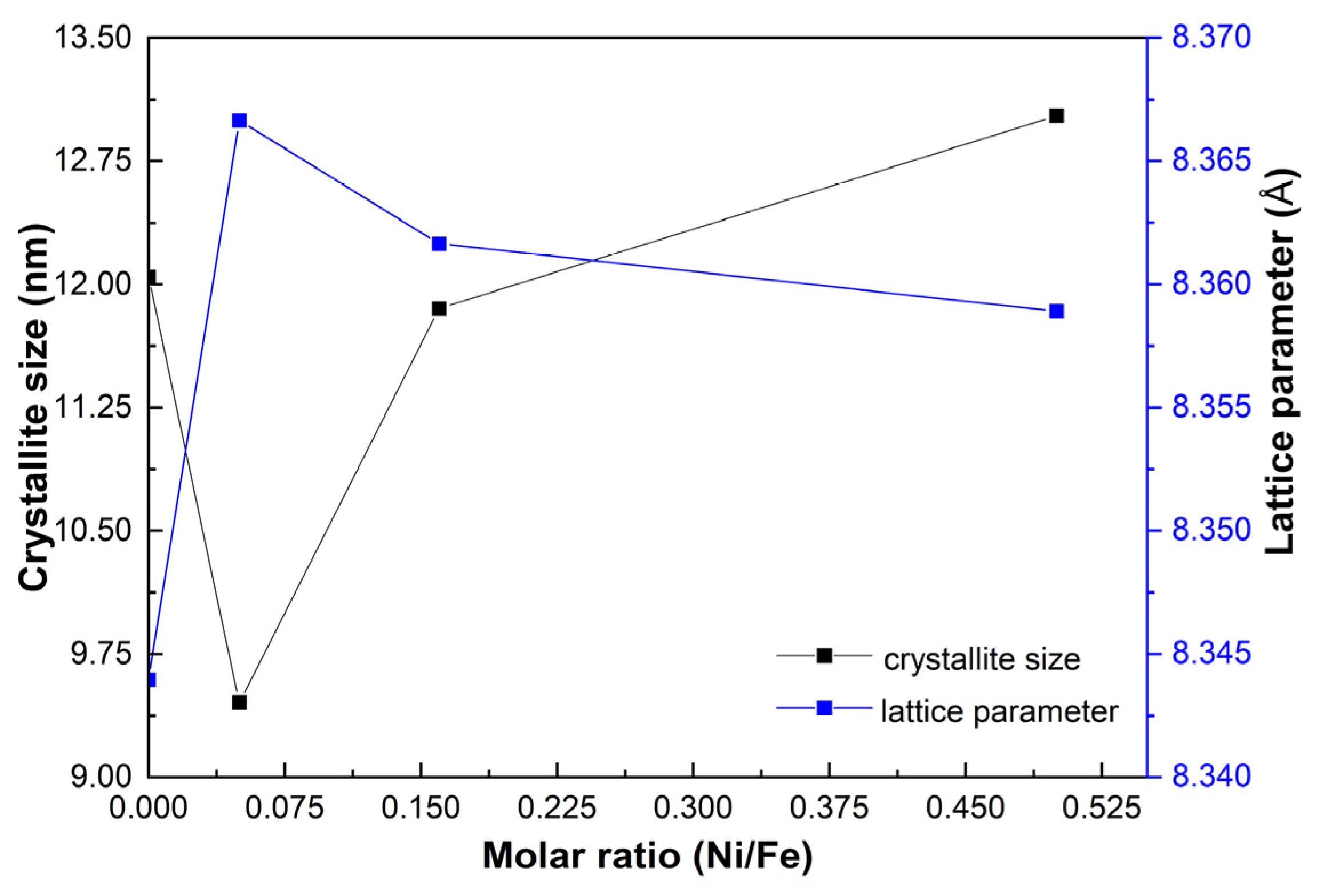

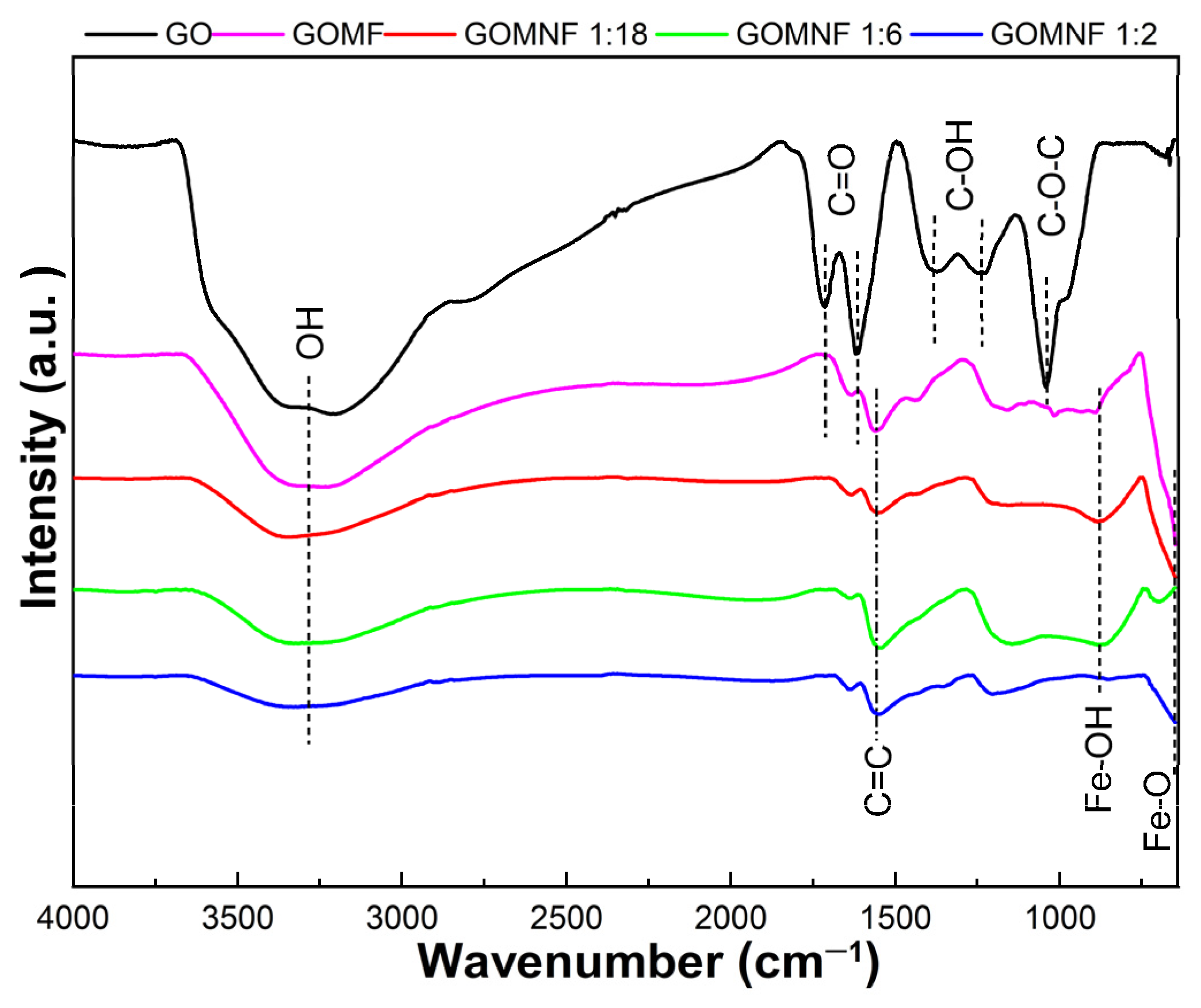
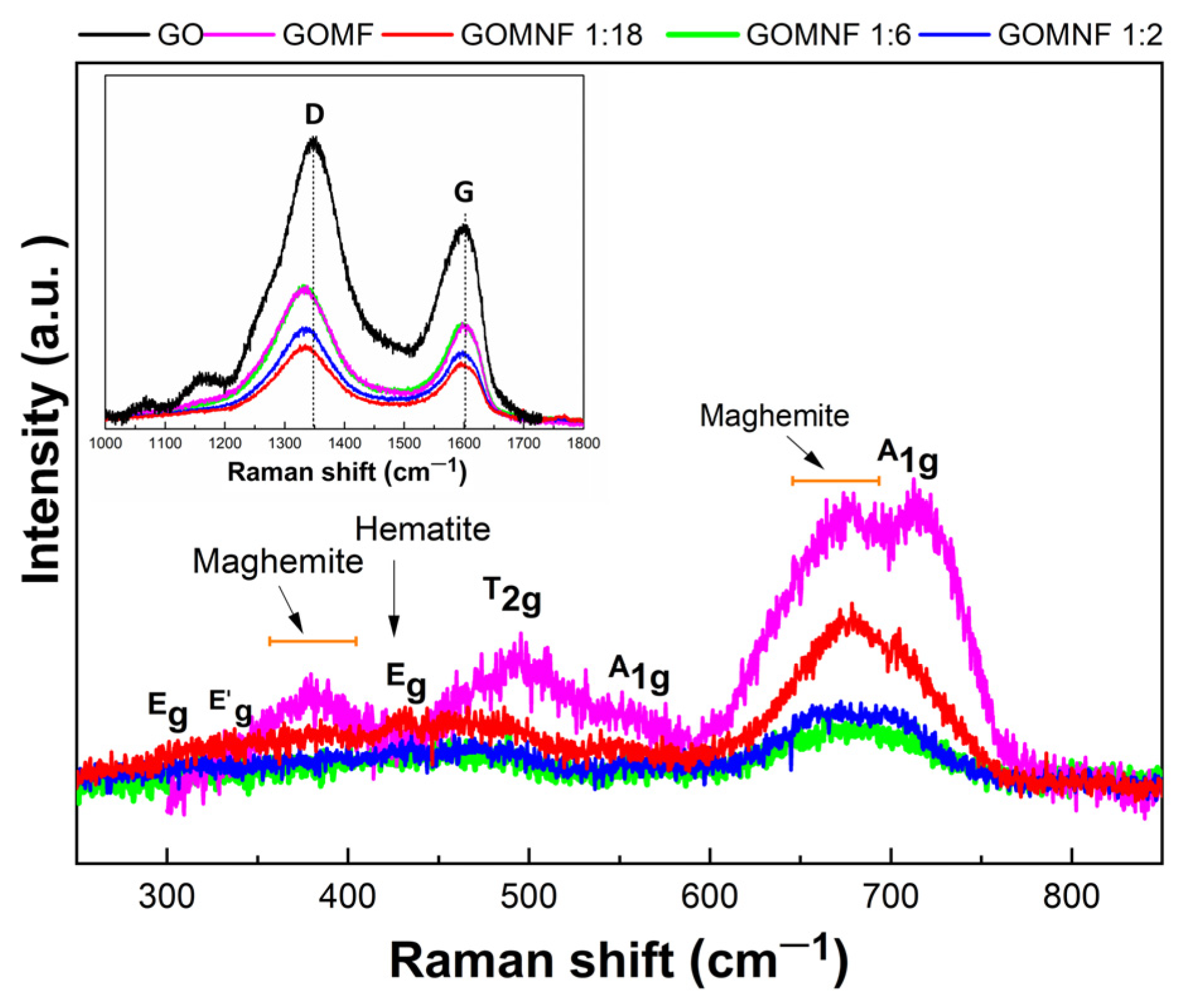
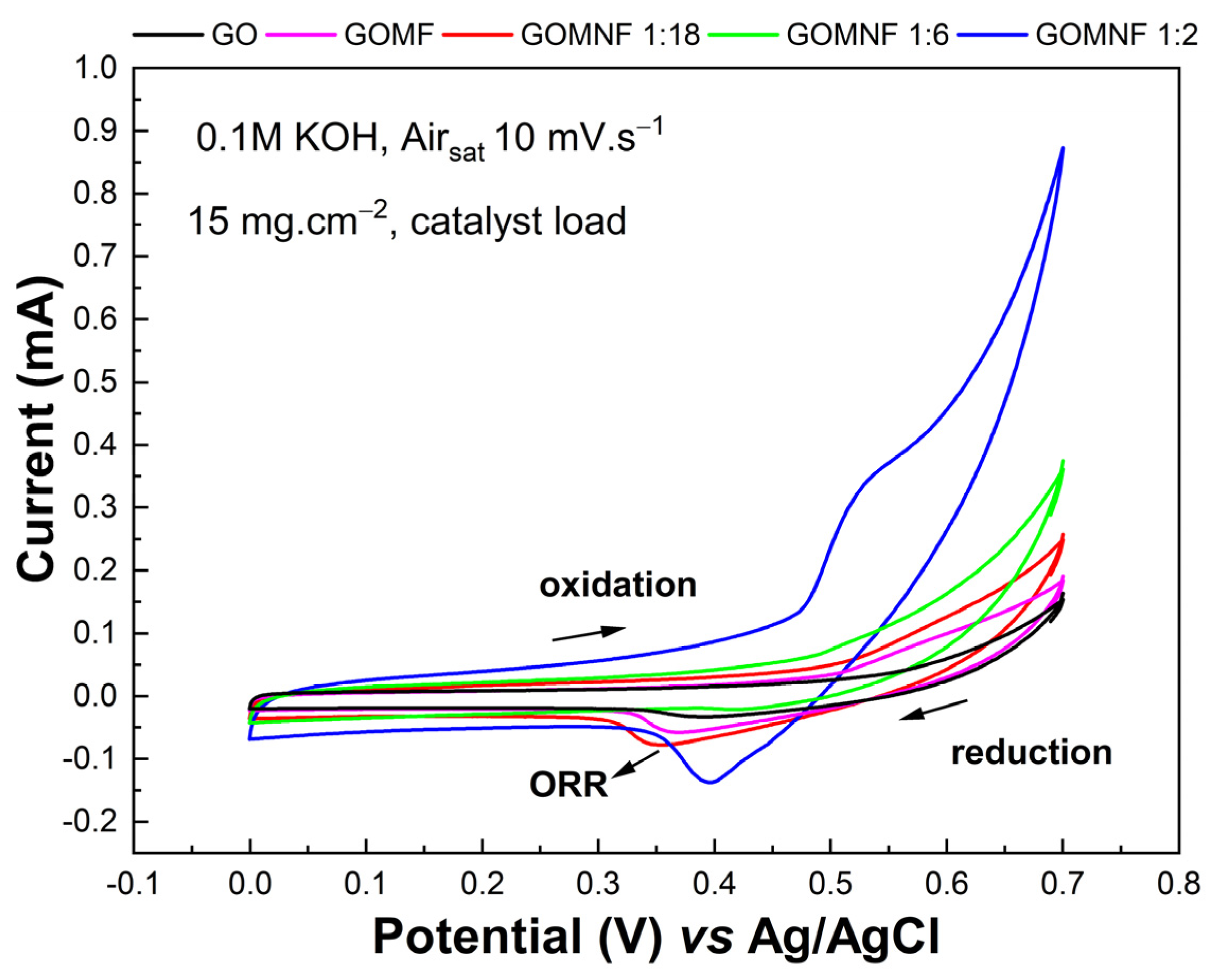
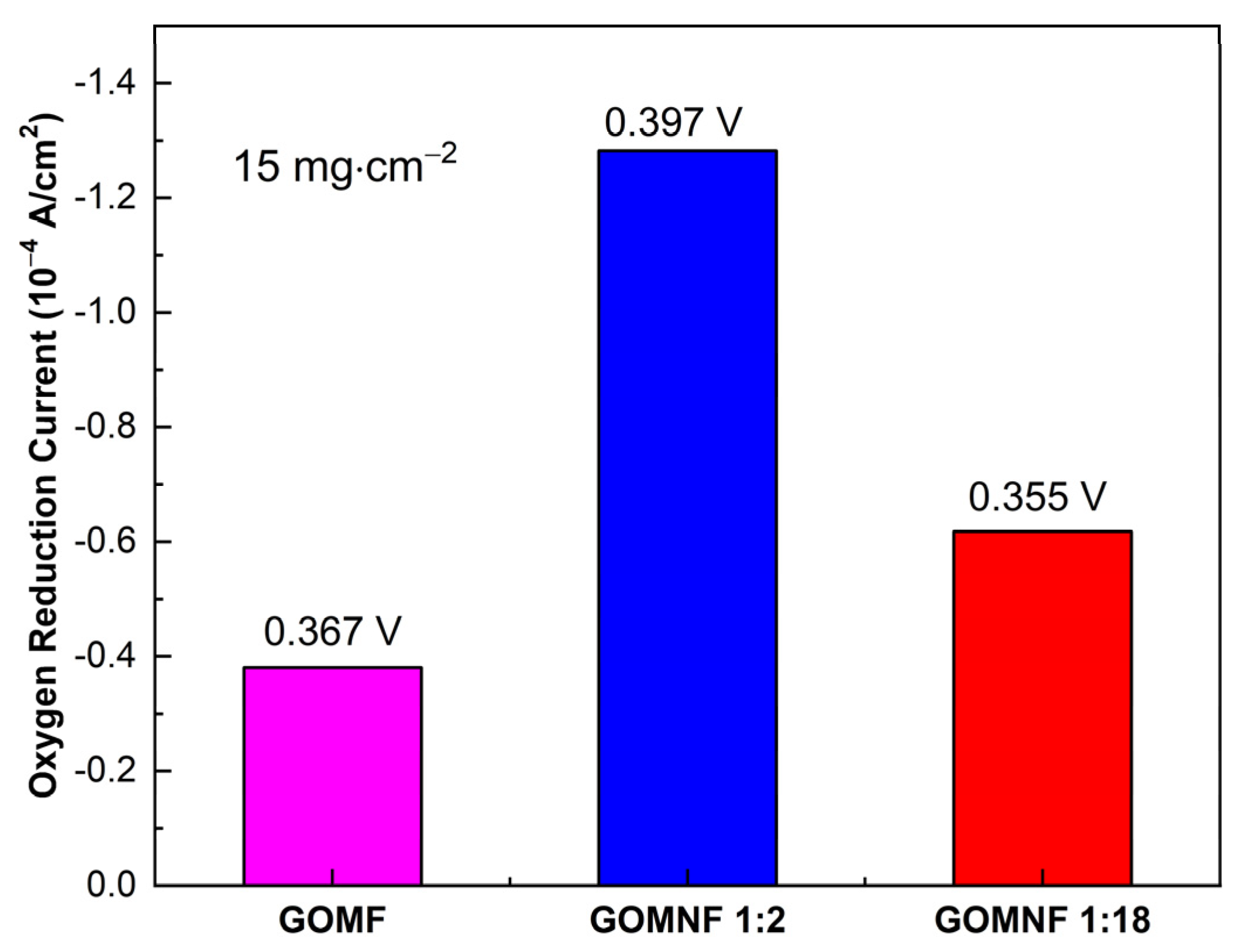

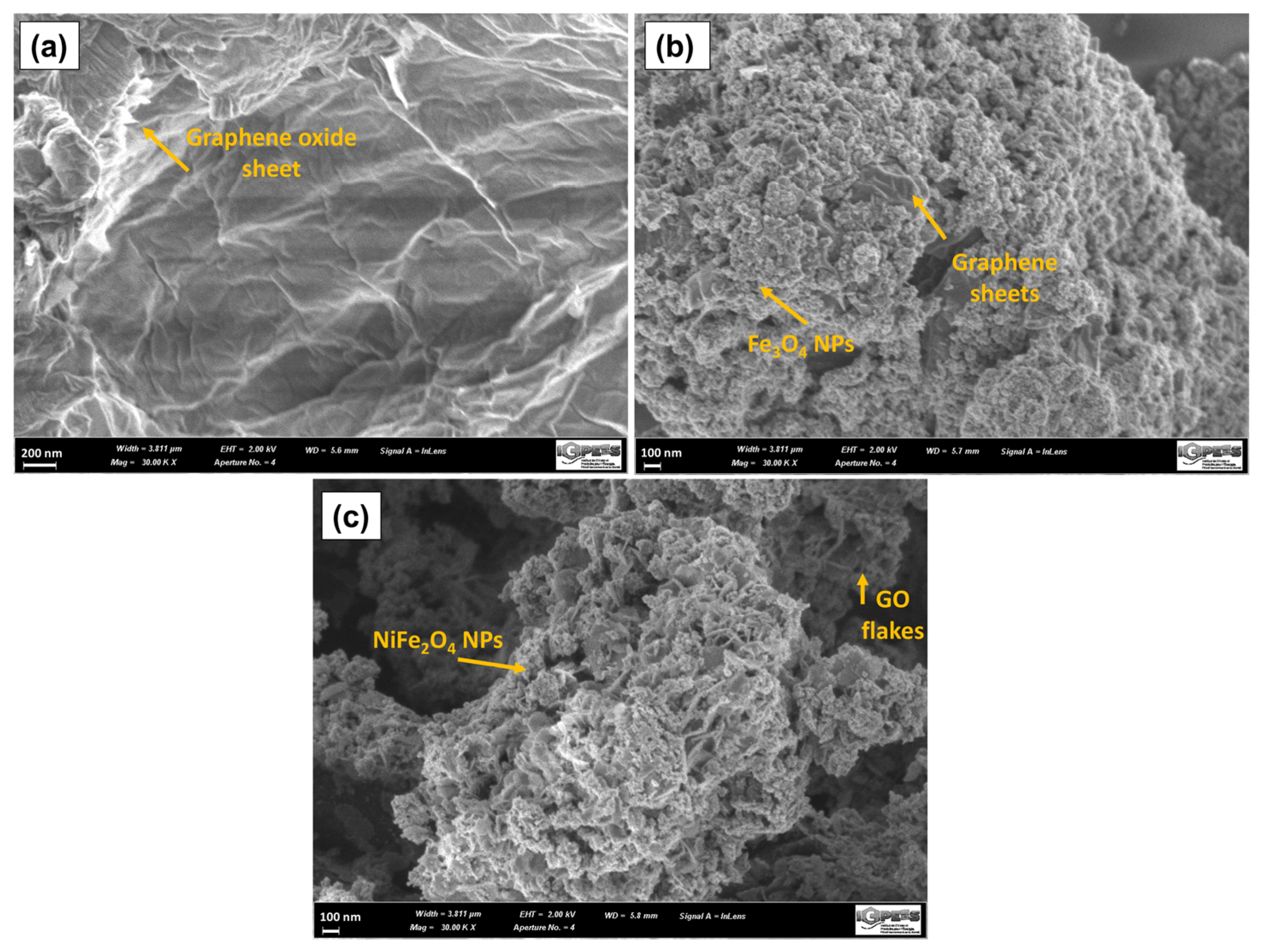
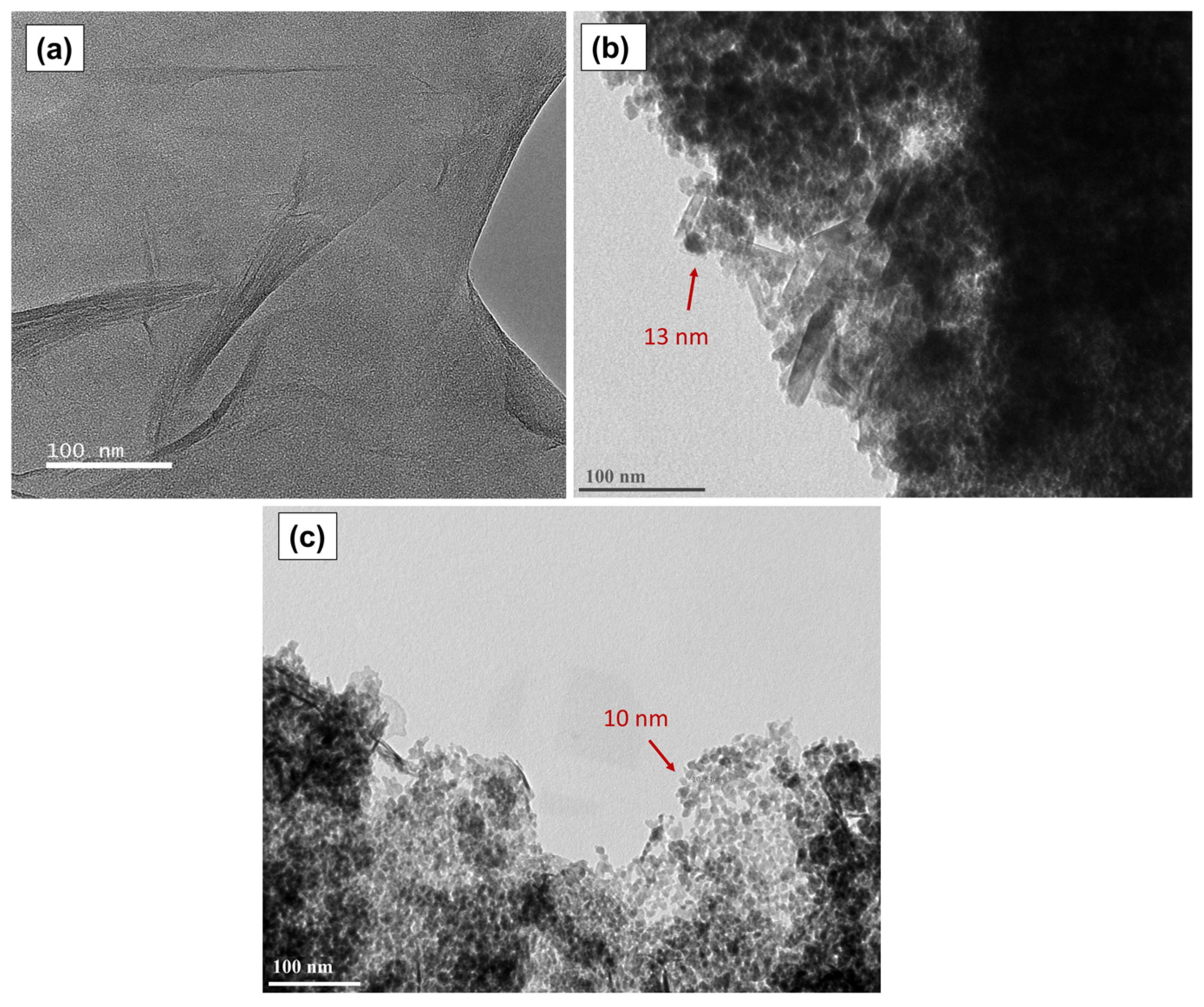
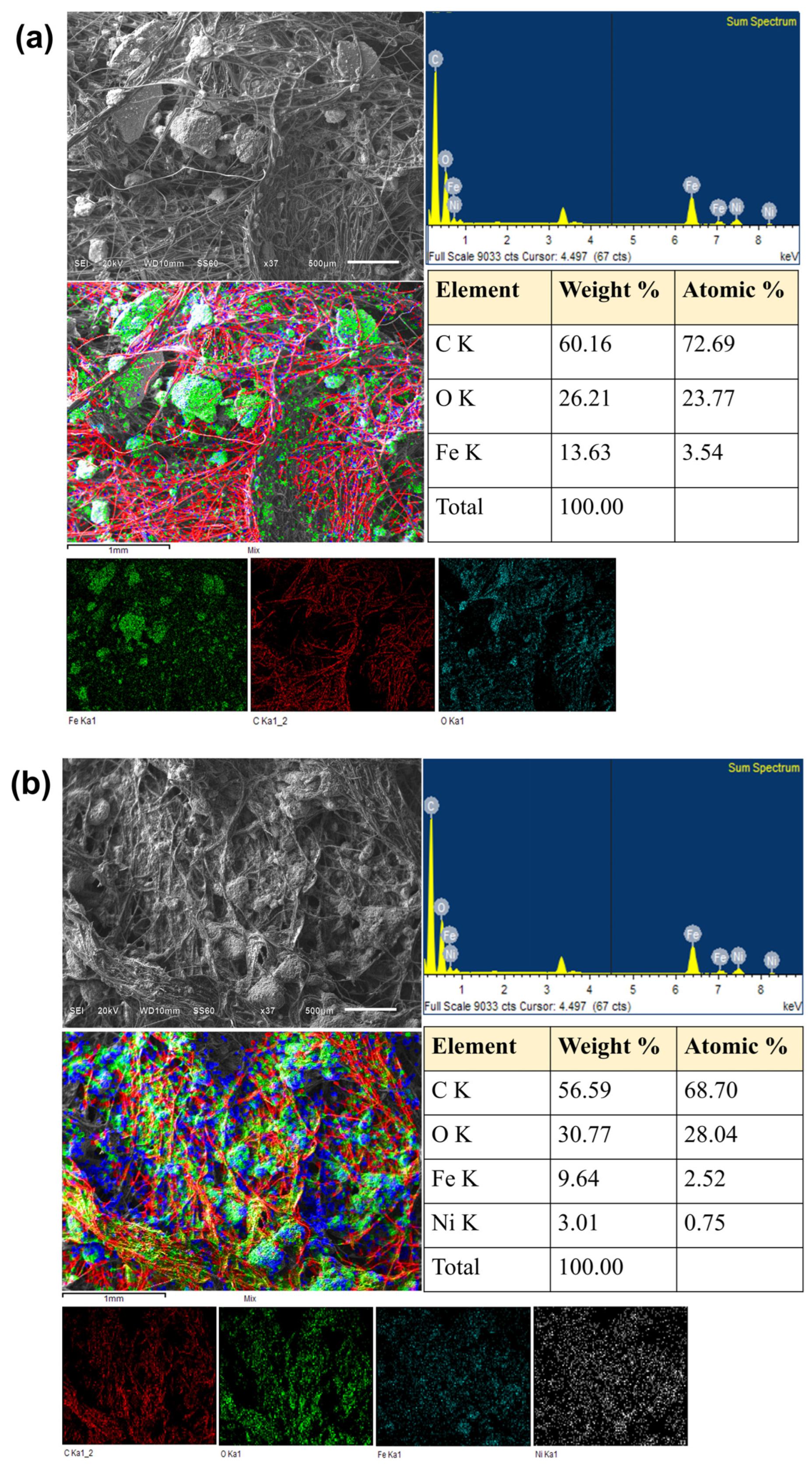
| Variation | NiCl2 | FeCl3·6H2O | FeCl2·4H2O | Volume (mL) of the 0.1 M Ni2+ Solution | |
|---|---|---|---|---|---|
| Sample | |||||
| GOMF | 0 | 0.04 mol | 0.02 mol | 0 | |
| GOMNF 1:18 | 0.001 mol | 0.012 mol | 0.006 mol | 10 | |
| GOMNF 1:6 | 0.002 mol | 0.008 mol | 0.004 mol | 30 | |
| GOMNF 1:2 | 0.003 mol | 0.004 mol | 0.002 mol | 20 | |
| Materials | Type of MFC | Power Density (mW m−2) | Reference |
|---|---|---|---|
| N3/Fe/C-Pt | Single chamber | 504 | [60] |
| CoFe2O4@N-AC | Single chamber | 1770.8 | [61] |
| CoMn2O4/rGO | Double chamber | 361 | [62] |
| NrGO@Pd-GA | Single chamber | 391 | [63] |
| FeO nanoparticles/carbon paper | Double chamber | 145 | [64] |
| α-Fe2O3/polyaniline | Double chamber | 1502.72 | [65] |
| Ni, Co, and Cd-based | Double chamber | 1630.7 | [66] |
| NiCo2O4@MWCNTs | Single chamber | 356 | [67] |
| GO@NiFe2O4; (GOMNF 1:2) | Single chamber | 508 | This work |
| GO@Fe3O4; (GOMF) | Single chamber | 139 | This work |
Disclaimer/Publisher’s Note: The statements, opinions and data contained in all publications are solely those of the individual author(s) and contributor(s) and not of MDPI and/or the editor(s). MDPI and/or the editor(s) disclaim responsibility for any injury to people or property resulting from any ideas, methods, instructions or products referred to in the content. |
© 2025 by the authors. Licensee MDPI, Basel, Switzerland. This article is an open access article distributed under the terms and conditions of the Creative Commons Attribution (CC BY) license (https://creativecommons.org/licenses/by/4.0/).
Share and Cite
Benito-Santiago, S.E.; Vigolo, B.; Ghanbaja, J.; Bégin, D.; Kamaraj, S.-K.; Caballero-Briones, F. Synthesis and Characterization of Ni-Doped Iron Oxide/GO Nanoparticles by Co-Precipitation Method for Electrocatalytic Oxygen Reduction Reaction in Microbial Fuel Cells. Ceramics 2025, 8, 40. https://doi.org/10.3390/ceramics8020040
Benito-Santiago SE, Vigolo B, Ghanbaja J, Bégin D, Kamaraj S-K, Caballero-Briones F. Synthesis and Characterization of Ni-Doped Iron Oxide/GO Nanoparticles by Co-Precipitation Method for Electrocatalytic Oxygen Reduction Reaction in Microbial Fuel Cells. Ceramics. 2025; 8(2):40. https://doi.org/10.3390/ceramics8020040
Chicago/Turabian StyleBenito-Santiago, Sandra E., Brigitte Vigolo, Jaafar Ghanbaja, Dominique Bégin, Sathish-Kumar Kamaraj, and Felipe Caballero-Briones. 2025. "Synthesis and Characterization of Ni-Doped Iron Oxide/GO Nanoparticles by Co-Precipitation Method for Electrocatalytic Oxygen Reduction Reaction in Microbial Fuel Cells" Ceramics 8, no. 2: 40. https://doi.org/10.3390/ceramics8020040
APA StyleBenito-Santiago, S. E., Vigolo, B., Ghanbaja, J., Bégin, D., Kamaraj, S.-K., & Caballero-Briones, F. (2025). Synthesis and Characterization of Ni-Doped Iron Oxide/GO Nanoparticles by Co-Precipitation Method for Electrocatalytic Oxygen Reduction Reaction in Microbial Fuel Cells. Ceramics, 8(2), 40. https://doi.org/10.3390/ceramics8020040







